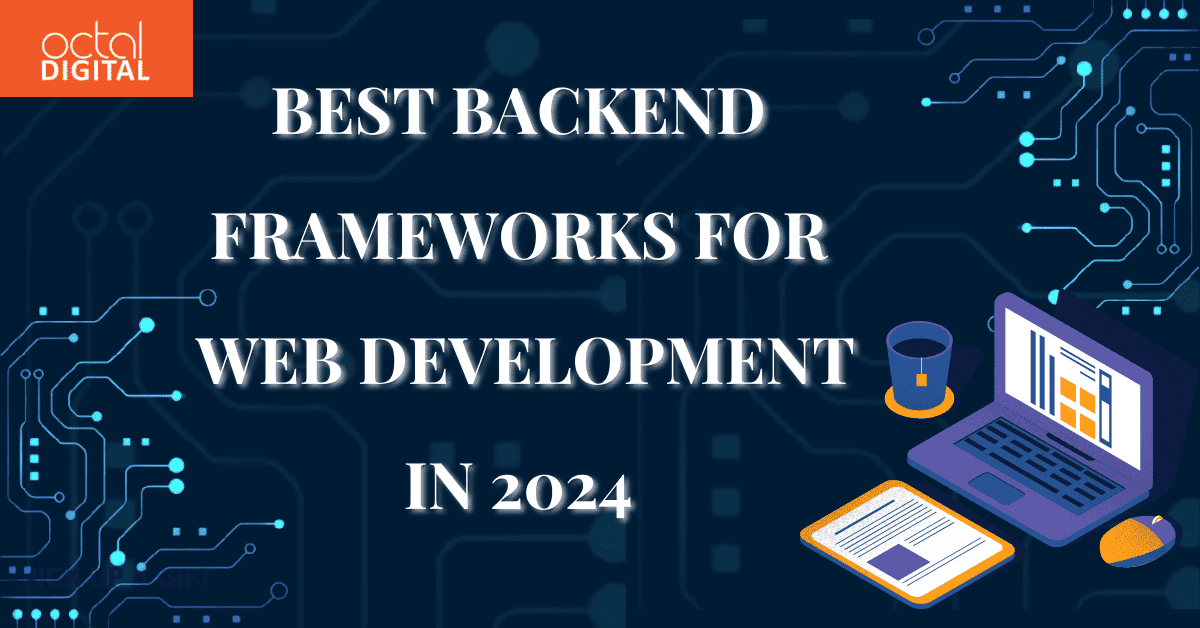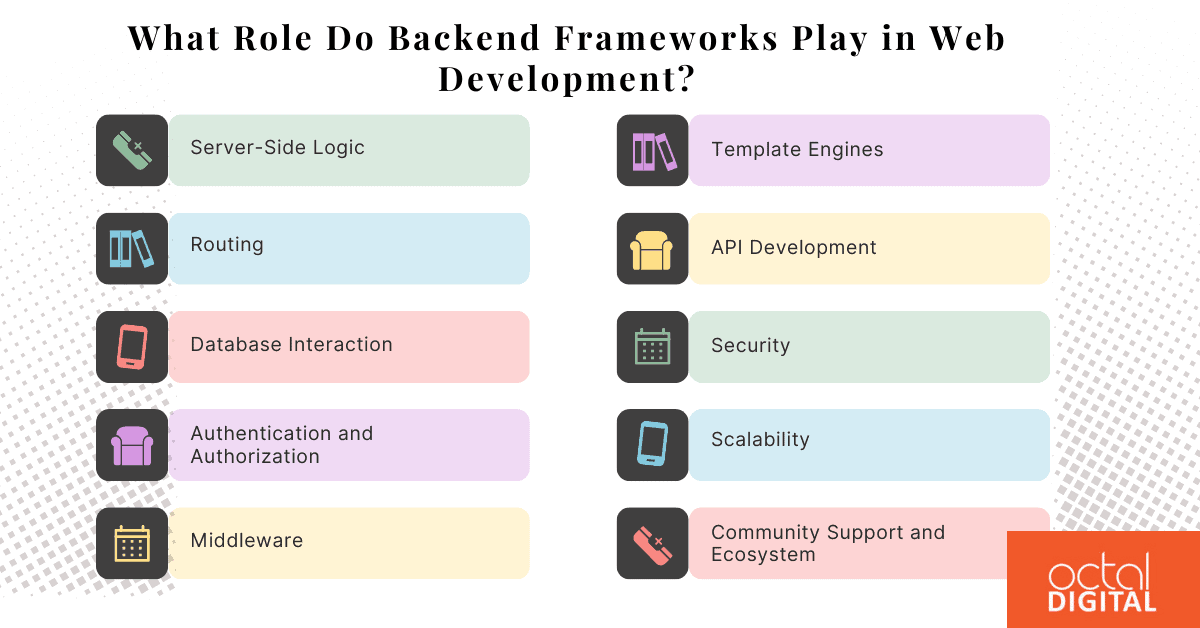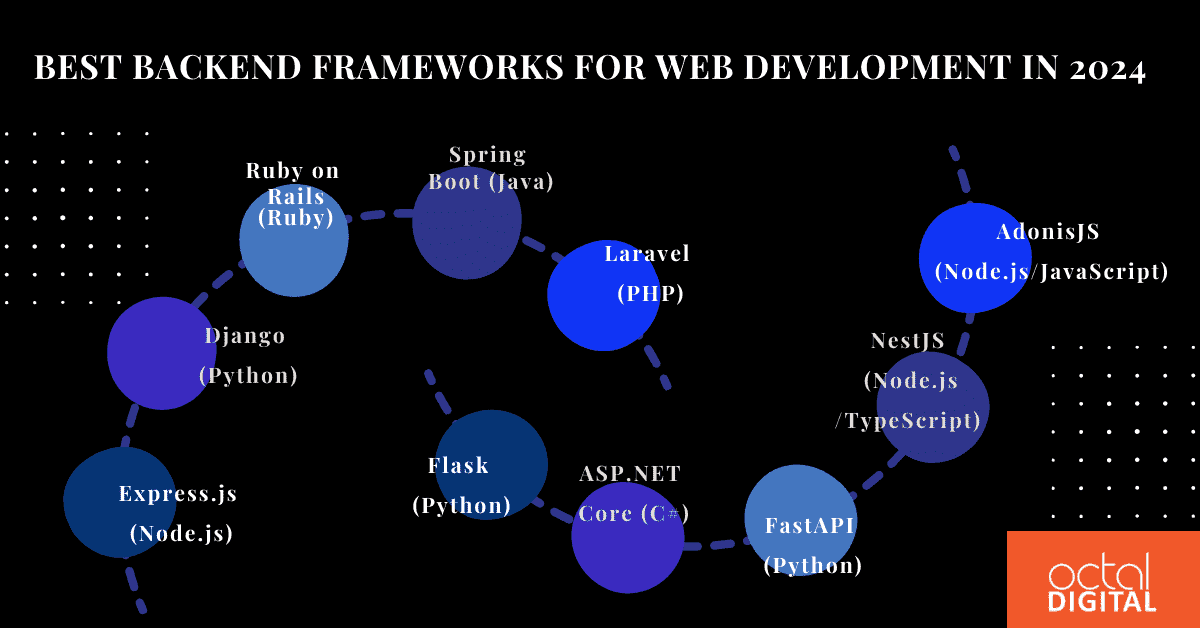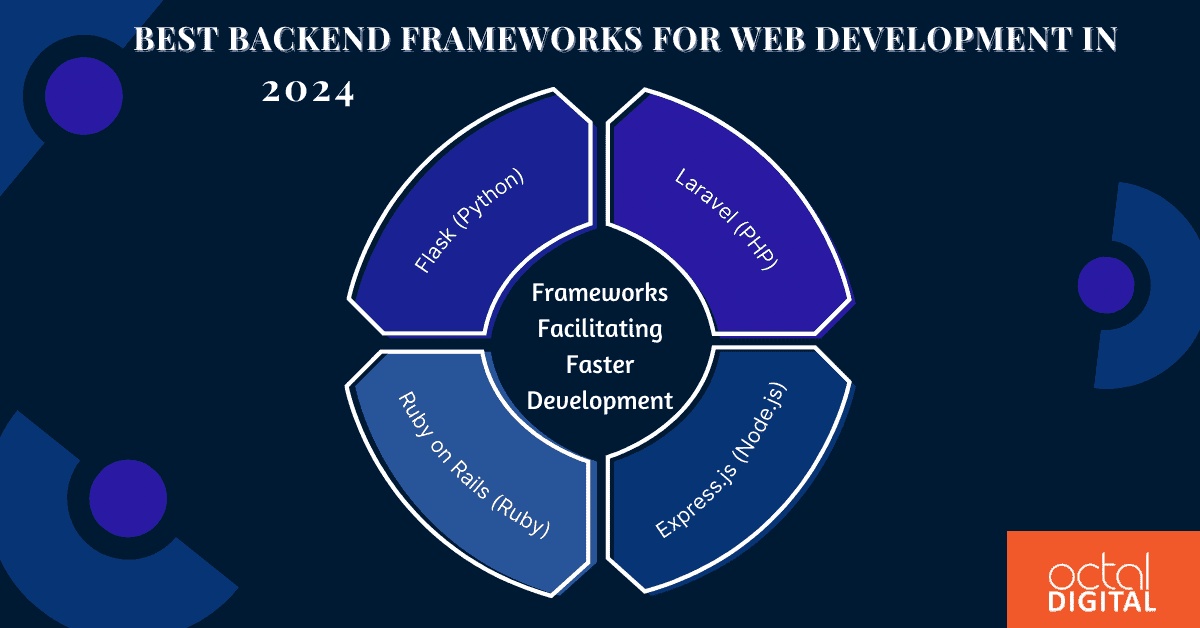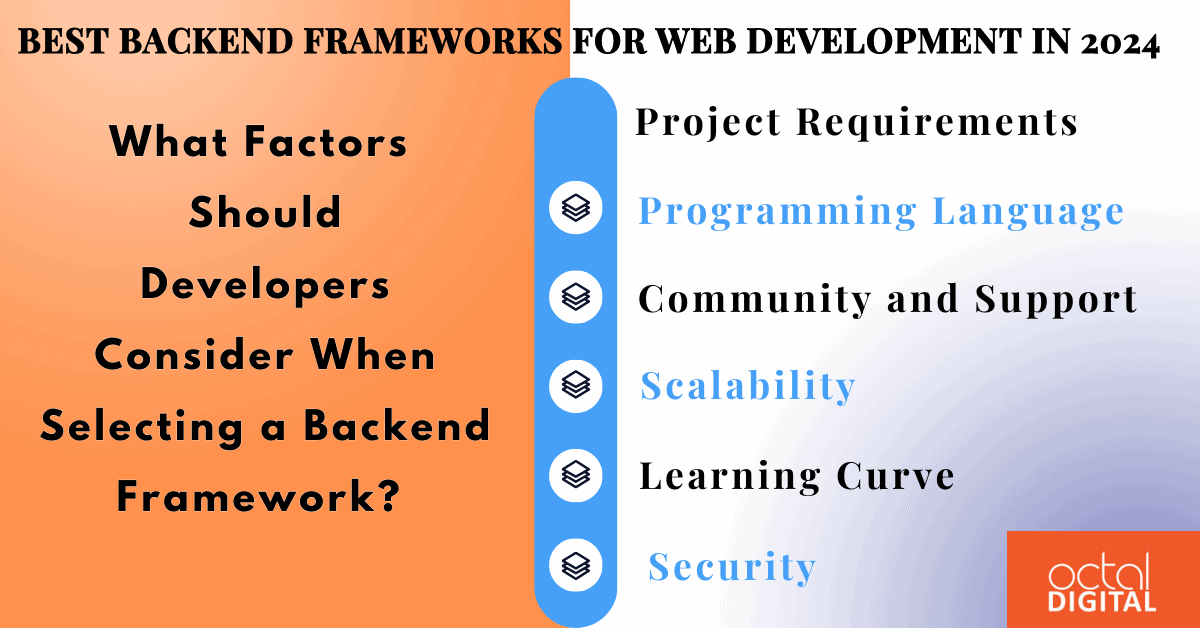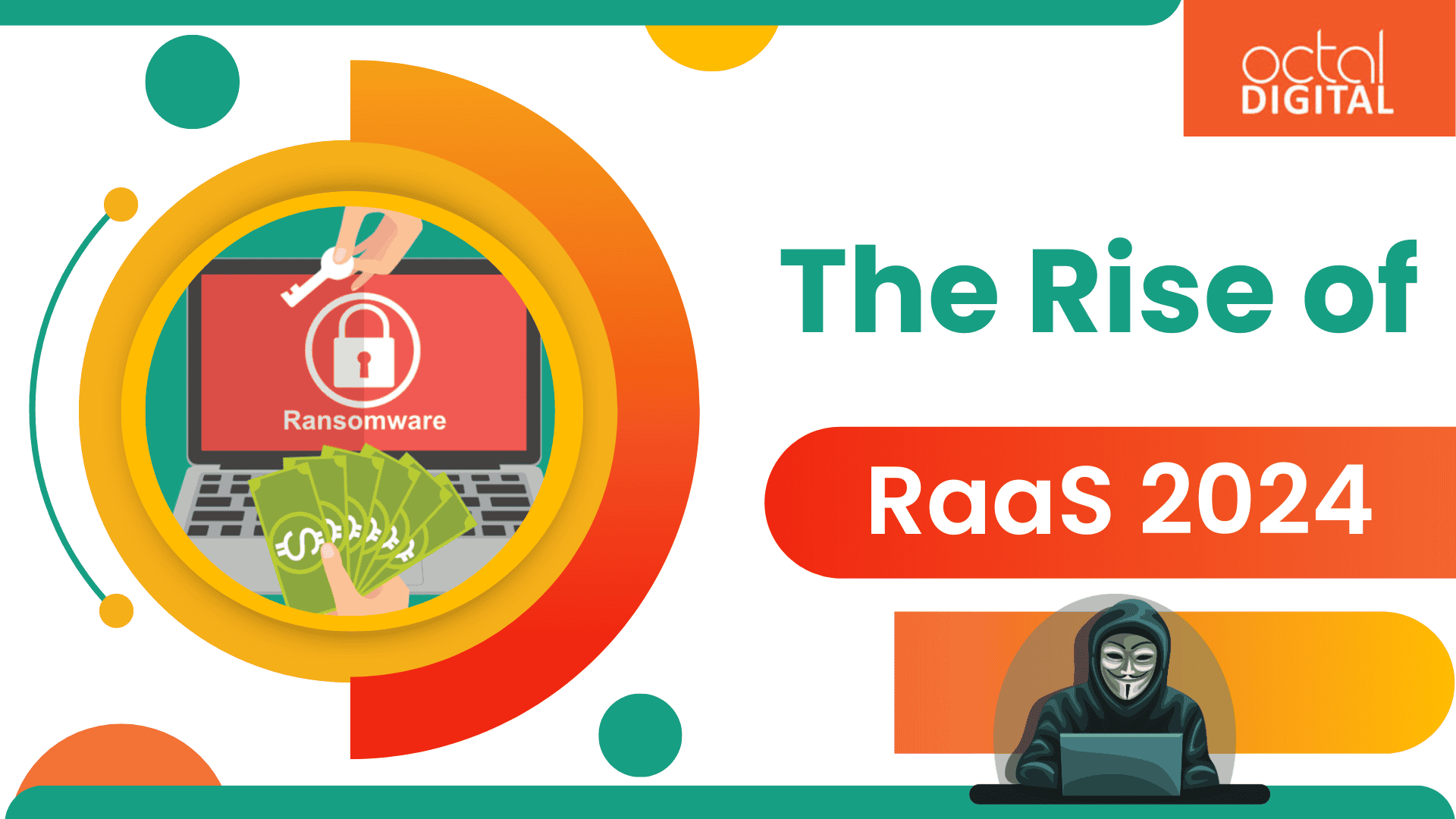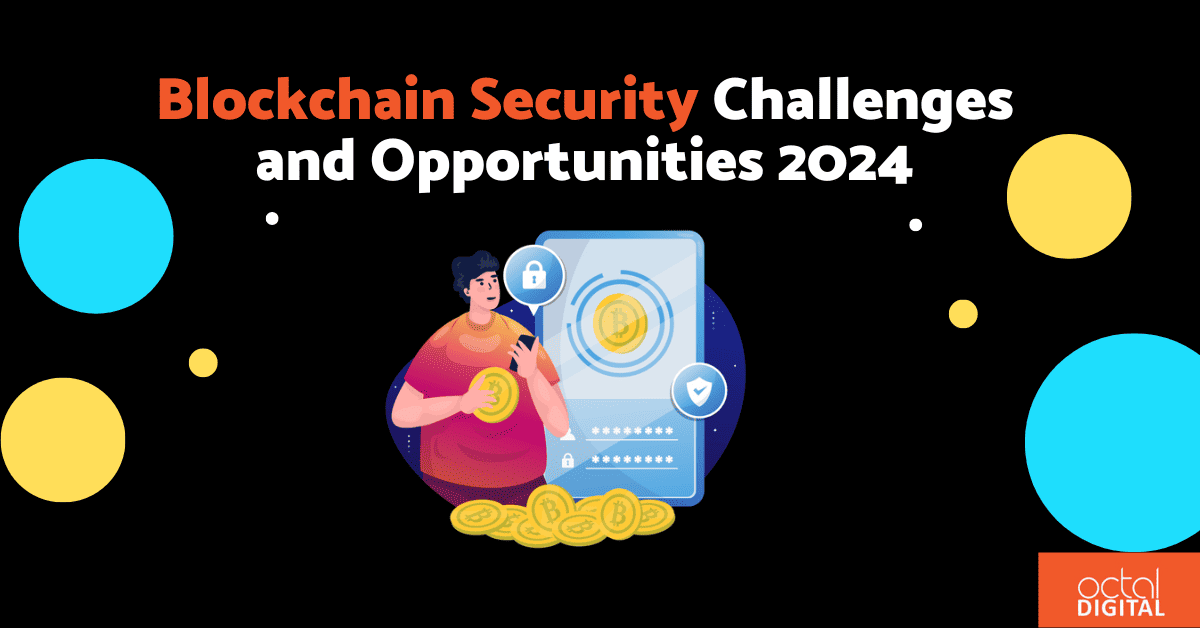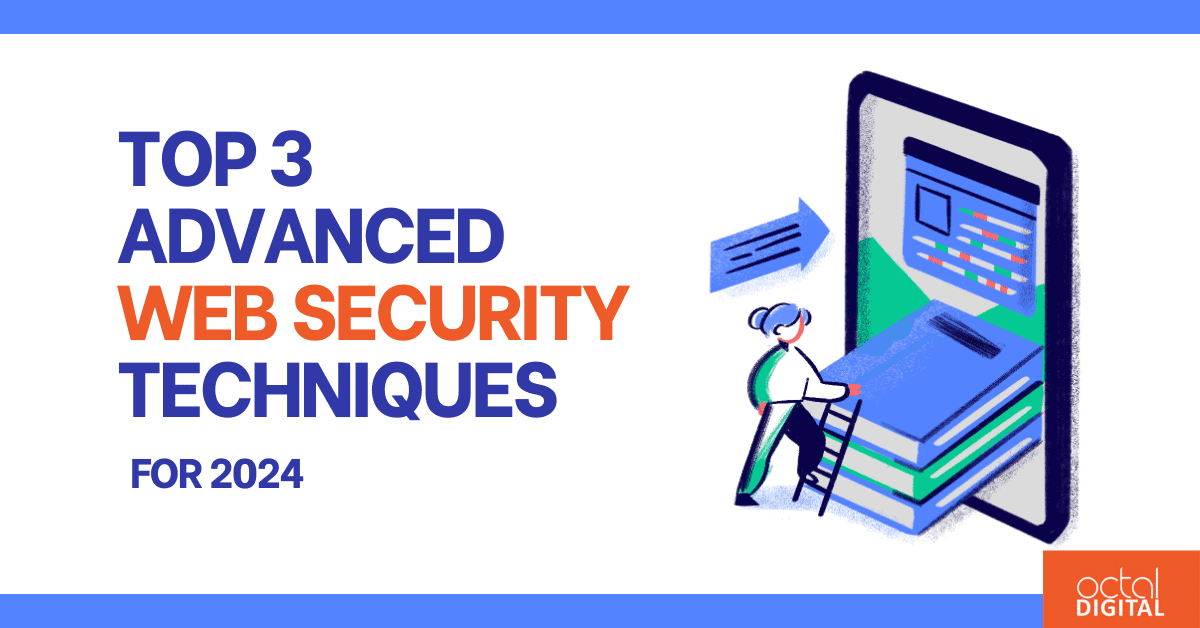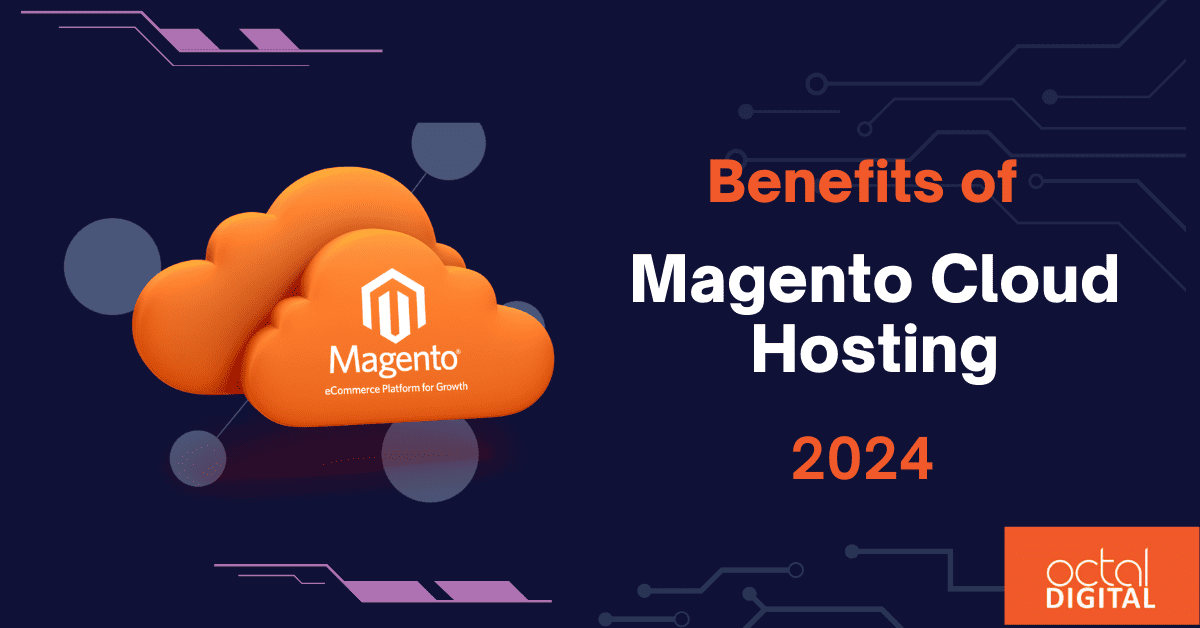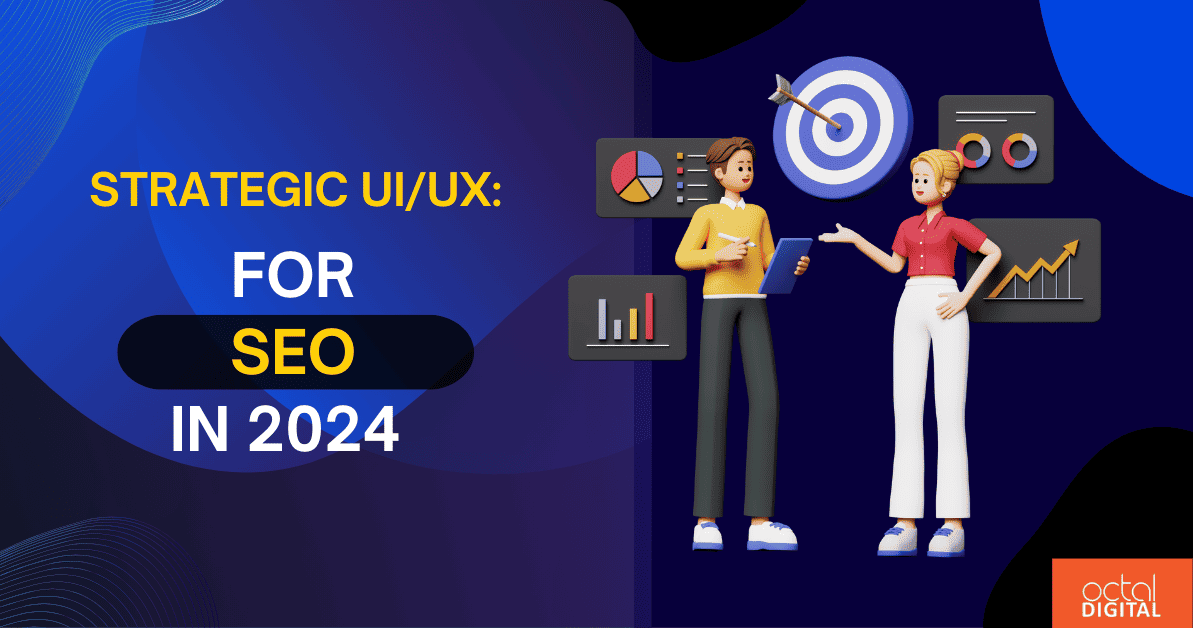Welcome to the forefront of web development in 2024, where the choice of a backend framework is more critical than ever. Choosing the right backend framework is paramount as it forms the backbone of a web application, influencing its performance, scalability, and overall success.
Whether you are a pro or just getting started, knowing the standout features of the best backend frameworks this year is an advantage. Learn how these features set the foundation for successful and forward-looking web applications.
This blog concisely explores the top backend frameworks driving innovation and efficiency in web development. Let’s go!
Understanding Best Backend Frameworks: Role
Backend frameworks provide a structured foundation for developing server-side logic in web applications. They streamline the development process by offering pre-built modules, libraries, and tools. This allows developers to focus on application-specific features rather than reinventing the wheel.
Backend frameworks handle tasks such as database interactions, authentication, and routing, significantly reducing development time. They contribute to the scalability, maintainability, and security of web applications.
Here are the key roles and contributions of backend frameworks in the web development process:
-
Server-Side Logic:
Processing Requests: Backend frameworks facilitate the handling of incoming requests from clients, processing them, and generating appropriate responses. This includes managing HTTP requests, handling form submissions, and responding to API calls.
-
Routing:
URL Routing: Frameworks define and manage URL routes, allowing developers to map specific URLs to corresponding server-side functions or controllers. This helps organize and structure the application’s navigation.
-
Database Interaction:
ORM (Object-Relational Mapping): Backend frameworks often come with built-in or integrated ORM systems that simplify database interactions. This abstraction layer allows developers to interact with databases using high-level programming constructs rather than raw SQL queries.
-
Authentication and Authorization:
User Management: Backend frameworks provide mechanisms for user authentication and authorization. This includes features such as user registration, login/logout, and access control to different parts of the application.
-
Middleware:
Request Processing: Middleware components in frameworks enable developers to inject logic that executes before or after the main request-handling process. This can include tasks like logging, authentication checks, and data parsing.
-
Template Engines:
Dynamic Content Generation: Backend frameworks often include template engines that simplify the generation of dynamic content. This allows developers to embed server-side code within HTML templates, making it easier to generate dynamic pages.
-
API Development:
RESTful Services: Many backend frameworks support the development of RESTful APIs. This is crucial for building web services that can be consumed by front-end applications, mobile apps, or other third-party services.
-
Security:
Protection Against Common Threats: Backend frameworks often include built-in security features to protect against common web vulnerabilities. This may include input validation, protection against SQL injection, and cross-site scripting (XSS) prevention.
Read More: WordPress vs Wix – Which Is The Best CMS 2022?
-
Scalability:
Scaling Capabilities: Backend frameworks are designed to handle the complexities of scaling applications. This includes managing concurrent connections, load balancing, and optimizing performance for increased traffic.
-
Community Support and Ecosystem:
Community-Driven Development: Many backend frameworks have large and active communities. This ensures ongoing support, updates, and a wealth of third-party libraries and plugins that can be leveraged to enhance functionality. This also ensures that your web development is up to date as per the latest trends, giving you a free hand to follow the best practices. Also, if you are looking to hire expert developers who understand your product, give Octal Digital, the best web development company in Houston, a shot. We have years of expertise, offering solid frameworks meant to handle scalability for the future.
Why Are Backend Frameworks Essential for Building Robust Web Applications?
Robust web applications require a well-organized backend to handle various tasks seamlessly. Backend frameworks ensure code consistency, making it easier for teams to collaborate and maintain the codebase. They implement design patterns like MVC (Model-View-Controller), promoting modular and scalable architectures. Additionally, backend frameworks often integrate security measures, reducing vulnerabilities and enhancing the overall robustness of web applications.
Best Backend Frameworks for Web Development in 2024?
Here is a detailed list of the best backend frameworks for web development:
-
Express.js (Node.js)
Express.js is a minimalist and flexible Node.js web application framework that simplifies the process of building scalable and robust web applications. It is designed to create efficient server-side applications, APIs, and microservices. Leveraging the speed of Node.js, Express is widely adopted for its simplicity and versatility.
Key Features:
- Middleware Support: Allows the use of middleware functions to handle tasks such as authentication and logging, enhancing extensibility.
- Routing: Implements a powerful routing system for defining endpoints and handling HTTP requests.
- Speed and Efficiency: Known for its lightweight nature, making it ideal for high-performance tasks.
- Large Community: Benefits from a large and active community, ensuring continuous support and updates.
-
Django (Python)
Django, a high-level Python web framework, follows the “Don’t Repeat Yourself” (DRY) and “Convention Over Configuration” (CoC) principles. It is equipped with an arsenal of tools and features that streamline the development process and promote best practices.
Key Features:
- Batteries-Included Philosophy: Comes with built-in admin panels, authentication, and an ORM system for database interaction.
- Django REST Framework: A powerful toolkit for building Web APIs, providing serialization and authentication.
- MVC Architecture: Organizes code using the Model-View-Controller (MVC) pattern for maintainability.
- Security: Incorporates built-in protections against common web vulnerabilities.
Read More: Xbox Cloud Gaming and Beyond in 2024
-
Ruby on Rails (Ruby)
Ruby on Rails, commonly known as Rails, is a web application framework written in Ruby. It adheres to the principle of convention over configuration, favoring sensible defaults and reducing the need for explicit programming.
Key Features:
- Convention Over Configuration: Reduces decision fatigue by relying on conventions for setup, naming, and structure.
- Active Record Pattern: Simplifies database interactions by treating database tables as classes and rows as objects.
- Scaffolding: Generates a basic structure for rapid prototyping and development.
- Developer-Friendly Syntax: Emphasizes elegant and readable code for increased productivity.
-
Spring Boot (Java)
Spring Boot is a Java-based framework built on the popular Spring framework. It focuses on making it easy to create production-ready applications with minimal setup. Spring Boot is particularly well-suited for building enterprise-level applications and microservices.
Key Features:
- Stand-Alone Applications: Allows the creation of standalone, production-grade Spring applications.
- Spring Data JPA: Simplifies data access by providing a set of abstractions over data repositories.
- Spring Security: Comprehensive security features for authentication and authorization.
- Microservices Support: Integrates seamlessly with Spring Cloud for developing microservices architectures.
-
Laravel (PHP)
Laravel is a PHP web framework that combines expressive syntax with an elegant design. It aims to make web development tasks enjoyable and efficient for developers, providing a modern toolkit for building versatile web applications.
Key Features:
- Eloquent ORM: A powerful and expressive ORM for interacting with databases using object-oriented syntax.
- Blade Templating Engine: A lightweight yet powerful templating engine for creating dynamic views.
- Artisan Command-Line Tool: Automates repetitive tasks and aids in project management.
- Laravel Mix: Simplifies asset compilation and management for CSS and JavaScript.
-
Flask (Python)
Flask is a lightweight and easy-to-extend Python web framework. It is designed to be simple and modular, allowing developers to choose the components they need. Flask is particularly well-suited for small to medium-sized projects.
Key Features:
- Microframework: Emphasizes simplicity and minimalism for rapid development.
- Werkzeug and Jinja2: Leverages these libraries for routing and templating, respectively.
- RESTful Request Dispatching: Supports RESTful request dispatching for building scalable APIs.
- Extensible: Allows the use of extensions to add functionality as needed.
-
ASP.NET Core (C#)
ASP.NET Core is a cross-platform, high-performance framework for building modern, cloud-based, and internet-connected applications. Developed by Microsoft, it is a modular and open-source framework that supports various programming languages.
Key Features:
- Cross-Platform: Runs on Windows, macOS, and Linux, offering flexibility in deployment.
- ASP.NET MVC: Implements the Model-View-Controller pattern for organized and scalable development.
- Integrated Dependency Injection: Built-in support for dependency injection, enhancing maintainability.
- Entity Framework Core: An Object-Relational Mapping (ORM) framework for database interactions.
-
FastAPI (Python)
FastAPI is a modern, fast (high-performance) web framework for building APIs with Python 3.7+. It is designed to be easy to use and understand while providing automatic validation and documentation for APIs.
Key Features:
- Fast: Utilizes the performance of Starlette and Pydantic for high-speed API development.
- Automatic Documentation: Generates interactive API documentation using OpenAPI and JSON Schema.
- Type Hints: Leverages Python-type hints for better code readability and editor support.
- Asynchronous Support: Supports asynchronous programming for handling concurrent operations.
Discover the must-read insights on our latest blog “Drupal CMS: A Right Choice in 2024?”.
-
NestJS (Node.js/TypeScript)
NestJS is a progressive Node.js framework for building scalable and maintainable server-side applications using TypeScript. It heavily relies on decorators and TypeScript features to create a highly modular and organized codebase.
Key Features:
- Modularity: Structures applications using modules, controllers, and services for maintainability.
- TypeScript Support: Takes full advantage of TypeScript for static typing and improved developer experience.
- Dependency Injection: Utilizes dependency injection for creating loosely coupled, testable components.
- Middleware and Pipes: Implements middleware and pipes for handling requests and responses in a modular way.
-
AdonisJS (Node.js/JavaScript)
AdonisJS is a full-featured Node.js framework for building robust web applications. It follows the MVC pattern and provides a set of conventions and abstractions to simplify the development process.
Key Features:
- MVC Architecture: Organizes code using the Model-View-Controller pattern for better structure.
- Lucid ORM: A powerful and expressive ORM for database interactions.
- Ace CLI: Command-line tools for tasks such as migrations, database seeding, and more.
- Authentication and Authorization: Built-in support for user authentication and authorization.
If you are a brand investing in a Shopify store, we offer state-of-the-art Shopify web development company Houston services. We have 12+ years of expertise in delivering robust Shopify stores that have unlocked new heights for businesses!
Comparison Table of Best Backend Frameworks in 2024
| Language | Architecture | Key Strengths | Database Interaction | Community Support | Security Features |
| Express.js | JavaScript | Middleware | Lightweight, Fast | Multiple databases, ORM | Large |
| Django | Python | MVC | Batteries Included, ORM | ORM | Large |
| Ruby on Rails | Ruby | MVC | Convention Over Configuration, Developer Productivity | Active Record pattern | Large |
| Spring Boot | Java | Microservices | Enterprise-Grade, Microservices | Spring Data JPA | Large |
| Laravel | PHP | MVC | Elegant Syntax, Developer-Friendly | Eloquent ORM | Large |
| Flask | Python | Microframework | Simplicity, Extensibility | Werkzeug, Jinja2 | Large |
| ASP.NET Core | C# | MVC | Cross-Platform, ASP.NET MVC | Entity Framework Core | Large |
| FastAPI | Python | Fast, ASGI | Fast Development, Automatic Documentation | Pydantic, ORM | Growing |
| NestJS | TypeScript | MVC | TypeScript Support, Modularity | Lucid ORM | Large |
| AdonisJS | JavaScript | MVC | MVC Architecture, ORM | Lucid ORM | Moderate |
How Do These Frameworks Compare in Terms of Performance and Flexibility?
Performance and flexibility vary among backend frameworks based on factors like language, architecture, and community support. Express.js, being lightweight, is favored for high-performance tasks, while Django’s batteries-included approach may impact performance slightly.
Ruby on Rails prioritizes convention, sacrificing some flexibility for ease of use. Spring Boot’s Java foundation offers high performance and flexibility, and Laravel strikes a balance with its elegant syntax and rich feature set.
Choosing the right framework depends on the specific needs and preferences of the development team.
Which Backend Framework Suits Your Project Needs?
Selecting the right backend framework depends on the project’s requirements. Express.js is excellent for building lightweight APIs and microservices. Django is a solid choice for the rapid development of feature-rich applications. Ruby on Rails is suitable for startups and projects with tight deadlines.
Spring Boot is preferred for large-scale enterprise applications. Laravel is versatile, offering a balance between simplicity and powerful features.
Consider factors like scalability, community support, and developer familiarity when making a decision. Follow the comparison table given above to find out the most relevant backend framework catering to your needs. If you need expert advice from the best web development company in Houston near me, get a customized quote for your project at Octal Digital!
Choosing the Right Backend Framework for Your Web Development Project in 2024
Here is a quick guide on what factors should be considered while choosing the right backend framework for your web app:
What Factors Should Developers Consider When Selecting a Backend Framework?
Selecting the right backend framework is a critical decision that depends on various factors. Developers should consider:
- Project Requirements: Evaluate the specific needs of your project, such as scalability, real-time features, or data processing requirements.
- Programming Language: Choose a framework that aligns with your team’s expertise and the nature of your project. Each language has its strengths and use cases.
- Community and Support: Assess the size and activity of the framework’s community. A robust community ensures ongoing support, updates, and a wealth of resources.
- Scalability: Consider the scalability requirements of your project. Some frameworks are better suited for handling large-scale applications and distributed architectures.
- Learning Curve: Evaluate the learning curve of each framework. Consider the experience and familiarity of your development team with the chosen technology.
- Security: Prioritize frameworks with built-in security features to safeguard your application against common vulnerabilities.
How Does the Choice of Backend Framework Impact the Scalability of a Web Application?
The choice of backend framework plays a crucial role in determining the scalability of a web application. Consider the following aspects:
- Performance: Some frameworks are optimized for high-performance tasks, making them suitable for scalable applications that demand rapid response times.
- Concurrency: Frameworks that support asynchronous operations and parallel processing are beneficial for handling a large number of simultaneous requests.
- Microservices Architecture: Certain frameworks, like Spring Boot, are designed with microservices in mind, allowing for modular and independently deployable components, and enhancing scalability.
- Database Scaling: Evaluate how well the framework handles database scaling, especially if your application involves a substantial amount of data processing.
- Caching Mechanisms: Look for frameworks that support efficient caching mechanisms to reduce the load on the server and enhance overall scalability.
Frameworks that Facilitate Faster Development Without Sacrificing Quality?
The following framework prioritizes rapid development without compromising code quality:
- Laravel (PHP): Laravel is known for its elegant syntax and a wide range of features that streamline development, allowing developers to build feature-rich applications quickly.
- Express.js (Node.js): Express.js, being minimalist, is well-suited for the rapid development of lightweight applications and APIs, providing a straightforward and flexible structure.
- Ruby on Rails (Ruby): Ruby on Rails follows the convention over the configuration principle, reducing the need for manual configuration and speeding up the development process.
- Flask (Python): Flask’s microframework approach simplifies development for small to medium-sized projects, making it an excellent choice for fast prototyping.
Conclusion
In conclusion, selecting the optimal backend framework is a critical decision in web development, influencing project success. Developers should meticulously assess project requirements, language compatibility, community support, scalability, and security features. The choice between frameworks like Laravel for rapid development, Spring Boot for enterprise-grade solutions, or FastAPI for high-performance APIs hinges on striking a balance between speed and code quality. Navigating this landscape requires a nuanced approach, ensuring the chosen framework aligns seamlessly with project goals and the evolving demands of the industry. Also, check that Octal Digital is a Partner with Design Rush.
FAQ’s
-
How do I decide which backend framework is best suited for my project?
The decision depends on factors such as project requirements, programming language preferences, scalability needs, and community support. Evaluating these aspects allows developers to make an informed choice tailored to the specific demands of their web development project. Hiring the right web developers company near me, like Octal Digital, is crucial. Ensure that you hire the best web development company in Houston, implementing the latest frameworks and best practices to ensure scalability.
-
Can I switch to a different backend framework after starting a project?
While technically possible, switching backend frameworks mid-project can be complex and time-consuming. It’s advisable to carefully choose a framework from the beginning to avoid compatibility issues and streamline the development process.
-
How does the choice of a backend framework impact the website’s search engine optimization (SEO)?
The backend framework indirectly influences SEO through factors like site speed, user experience, and mobile responsiveness. Opting for a backend framework that prioritizes these elements can positively influence to a website’s SEO performance.
